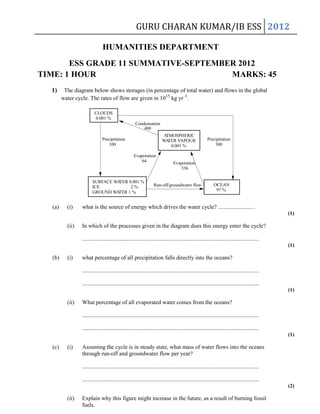
ESS grade 11 summative september 2012
- 1. GURU CHARAN KUMAR/IB ESS 2012 HUMANITIES DEPARTMENT ESS GRADE 11 SUMMATIVE-SEPTEMBER 2012 TIME: 1 HOUR MARKS: 45 1) The diagram below shows storages (in percentage of total water) and flows in the global water cycle. The rates of flow are given in 1015 kg yr–1. CLOUDS 0.001 % Condensation 400 A TMOSPHERIC WA TER VAPOUR 0.001 % Precipitation 100 Evaporation 64 SURFACE WA TER 0.001 % ICE 2% GROUND WA TER 1 % (a) (i) Precipitation 300 Evaporation 336 Run-off/groundwater flow OCEAN 97 % what is the source of energy which drives the water cycle? ........................ . (1) (ii) In which of the processes given in the diagram does this energy enter the cycle? ........................................................................................................................... (1) (b) (i) what percentage of all precipitation falls directly into the oceans? ........................................................................................................................... ........................................................................................................................... (1) (ii) What percentage of all evaporated water comes from the oceans? ........................................................................................................................... ........................................................................................................................... (1) (c) (i) Assuming the cycle is in steady state, what mass of water flows into the oceans through run-off and groundwater flow per year? ........................................................................................................................... ........................................................................................................................... (2) (ii) Explain why this figure might increase in the future, as a result of burning fossil fuels.
- 2. GURU CHARAN KUMAR/IB ESS 2012 ........................................................................................................................... ...........................................................................................................................(PTO) ........................................................................................................................... ........................................................................................................................... ........................................................................................................................... (3) (d) Name a storage of water in the biosphere that is not shown in the diagram, and explain how water is transferred in and out of this storage. ...................................................................................................................................... ...................................................................................................................................... ...................................................................................................................................... ...................................................................................................................................... ...................................................................................................................................... (3) (e) (i) State briefly one way in which one of the other flows in the diagram might change if evaporation rates were to increase. ........................................................................................................................... ........................................................................................................................... (1) (ii) Describe how two changes in the flows shown on the diagram could lead to a fall in global temperatures and reduce global warming. ........................................................................................................................... ........................................................................................................................... ........................................................................................................................... ........................................................................................................................... ........................................................................................................................... (4) (iii) Name the type of feedback involved in this reduction in global warming. ........................................................................................................................... (1) (f) Identify each of the different processes referred to on the diagram as either transfer or transformation processes. ......................................................................................................................................
- 3. GURU CHARAN KUMAR/IB ESS 2012 ...................................................................................................................................... ...................................................................................................................................... (2) (Total 20 marks) 2) a) Define the following terms. (i) Negative feedback ........................................................................................................................... ........................................................................................................................... (1) (ii) Positive feedback ........................................................................................................................... ........................................................................................................................... (1) (b) Suggest why most ecosystems are negative feedback systems. ...................................................................................................................................... ...................................................................................................................................... (1) The diagram below represents a coal fired power station. smoke ................. coal warm water [Source: Adapted from D D Kemp, Global Environment Issues, A Climatological Approach, (Taylor & Francis,1994) p. 7. Reproduced by permission of Cengage Learning] (c) Complete the diagram above by naming the missing input and the two missing outputs. (2) (Total 5 marks)
- 4. GURU CHARAN KUMAR/IB ESS 2012 3) a) (i) State the first law of thermodynamics. ........................................................................................................................... ........................................................................................................................... (1) (ii) Calculate the amount of energy output in the model below. Input 1000 kJ energy 10 % loss to atmosphere 15 % stored after loss to atmosphere OUTPUT = ? ........................................................................................................................... ........................................................................................................................... ........................................................................................................................... ........................................................................................................................... (2 (b) The diagram below represents a simplified hydrological cycle.
- 5. GURU CHARAN KUMAR/IB ESS 2012 ATMOSPHERE 2. 3. 1. 4. GROUND (i) Identify the processes corresponding to the arrows labeled 1 to 4 in the diagram. 1. ................................................................ 2. ................................................................ 3. ................................................................ 4. ................................................................ (2) (ii) Suggest one weakness in the model above. ........................................................................................................................... ........................................................................................................................... (1)
- 6. GURU CHARAN KUMAR/IB ESS 2012 The graph below shows the estimated world water withdrawals from 1960 to 2000. 4 3 Water withdrawals / 103 km3 yr–1 2 1 0 1960 1965 1970 1975 1980 1985 1990 1995 2000 Year [J Loh, The Living Planet Report, © [2002] WWF (panda.org). Some rights reserved.] (iii) Calculate the percentage increase in world water withdrawals from 1960 to 2000. ........................................................................................................................... ........................................................................................................................... ........................................................................................................................... ........................................................................................................................... (2) (iv) Suggest three reasons for the increase in water withdrawals during the period 1960 to 2000. ........................................................................................................................... ........................................................................................................................... ........................................................................................................................... ........................................................................................................................... ........................................................................................................................... ........................................................................................................................... ........................................................................................................................... (3) (Total 11 marks) 4) Figure 1 Relationship between number of rodent species and altitude Figure 2 Altitude habitat model 100
- 7. GURU CHARAN KUMAR/IB ESS 2012 100 s snowline Numbers of rodent species 0 (a) Altitude in metres 3000 mountain With reference to Figure 1 describe the relationship which appears to exist between altitude and the number of rodent species. ...................................................................................................................................... ...................................................................................................................................... (1) (b) Predict three ways in which the altitude habitat model in Figure 2 might change as a result of global warming. ...................................................................................................................................... ...................................................................................................................................... ...................................................................................................................................... ...................................................................................................................................... ...................................................................................................................................... ...................................................................................................................................... (3) (c) (ii) Explain the difference between an open system and a closed system.
- 8. GURU CHARAN KUMAR/IB ESS 2012 ........................................................................................................................... ........................................................................................................................... (2) (b) The first and second laws of thermodynamics suggest that energy is neither made or lost, merely transformed. Using a named ecosystem, outline how this occurs. ..................................................................................................................................... ..................................................................................................................................... ..................................................................................................................................... ..................................................................................................................................... ..................................................................................................................................... ..................................................................................................................................... (3) (Total 9 marks)
